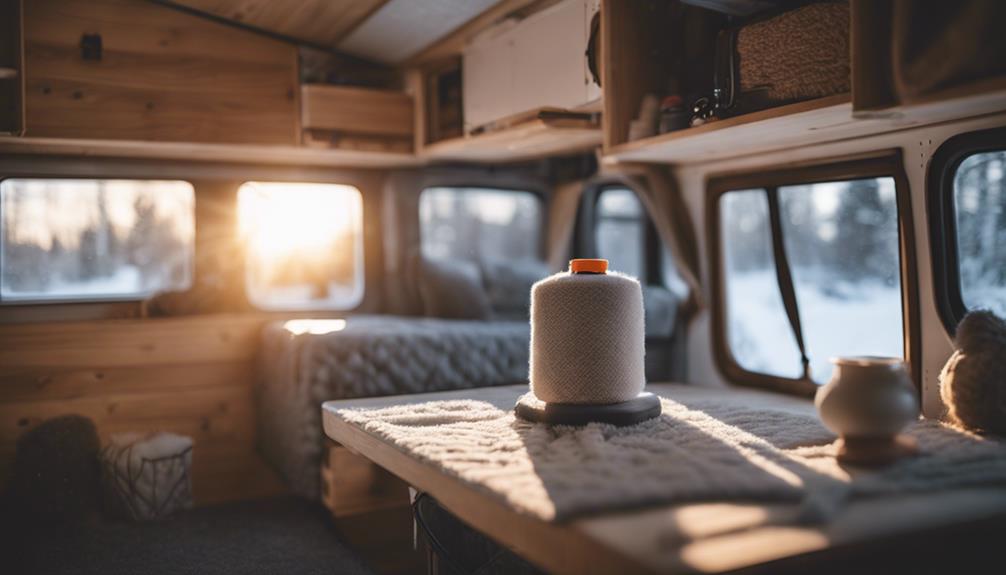For the best insulation in your camper conversion, consider combining materials for peak thermal performance. Spray foam is a top choice; it seals gaps and delivers an impressive R-value of up to 6.5 per inch. Pair that with Havelock Wool or 3M Thinsulate for added warmth and sound control. These materials not only keep you cozy in winter but also help maintain cool temperatures in summer. Don't forget to address thermal bridging with reflective barriers like Lizard Skin. Want to explore even more insulation options and techniques? There's a lot more to keep you comfortable on your adventures.
Introduction
When converting a camper, effective insulation can transform your travel experience by keeping you comfortable in any season. The right insulation is fundamental in a campervan conversion, as it regulates interior temperatures, allowing you to stay warm during chilly nights and cool on hot summer days.
Insulation materials have different thermal resistance levels, often measured by R-values. For example, 3M Thinsulate and Havelock Wool provide R-values of 3.8 and 3.6 per inch, respectively, making them excellent choices for your build.
Addressing thermal bridging is significant, too. Metal frame components can create paths for heat transfer, resulting in cold spots and reduced insulation effectiveness. To combat this, use a combination of insulation materials. Mass insulation for walls paired with thermal break layers like Lizard Skin can enhance overall performance and minimize heat loss.
However, even the best insulation won't work if it isn't installed properly. Sealing gaps and using pre-cut insulation kits tailored to specific van models are essential for maximizing your insulation system's efficiency.
With the right approach, you'll enjoy a comfortable journey, no matter the temperature difference outside.
Background Information
Over the years, insulation for camper conversions has evolved considerably, adapting to new materials and technologies.
You'll find various advancements that improve thermal efficiency and comfort, enhancing your travel experience.
Understanding these changes helps you choose the best insulation for your needs.
Insulation Evolution Over Decades
Insulation for camper conversions has transformed considerably, shifting from traditional materials like fiberglass and foam to advanced options such as PIR and Thinsulate, driven by a focus on thermal efficiency and sustainability.
In the 1970s, insulation primarily centered on basic thermal resistance, leading to the emergence of materials with higher R-values, such as extruded polystyrene (XPS) and polyisocyanurate (PIR). These materials excel in compact spaces, providing better performance.
In recent decades, innovative products like Havelock Wool and Lizard Skin have emphasized sustainability while enhancing insulation effectiveness and sound control. The rise of spray foam has also marked a significant advancement, boasting an impressive R-value of up to 6.5 per inch. Spray foam fills gaps and creates a seamless thermal barrier, making it an appealing choice for many van life enthusiasts.
As the popularity of camper conversions has surged, the insulation market has adapted by offering pre-cut insulation kits tailored for specific van models. This development simplifies the installation process, allowing DIY enthusiasts to achieve ideal insulation with minimal hassle.
The evolution of insulation materials reflects a commitment to both comfort and reducing environmental impact.
Insulation Materials Advancements
Recent innovations in insulation materials have revolutionized how you can optimize thermal efficiency in camper conversions. High-performance foam boards, like PIR insulation board, boast impressive thermal resistance, offering an R-value of about 4.16 for just 75mm thickness.
If you're looking for maximum efficiency, closed-cell spray foam insulation is a game-changer, delivering an R-value of 6.5 per inch while also creating an effective vapor barrier, making it ideal for various climates.
You might also consider innovative reflective insulation materials, such as bubble foil, which work best when there's at least a 1-inch air gap, particularly for window coverings.
Don't overlook natural options either; materials like Thinsulate and sheep wool provide sustainable solutions, with the latter regulating moisture while maintaining an R-value of around 3.5 per inch.
Recent Insulation Material Innovations

You'll find that recent innovations in insulation materials are pushing the boundaries of what's possible for camper conversions.
Eco-friendly options like mycelium-based products and denim insulation not only help the environment but also offer competitive R-values.
These advancements can transform your camper into a more energy-efficient and comfortable living space.
Emerging Eco-Friendly Insulation Options
Innovative eco-friendly insulation materials are transforming camper conversions, offering sustainable choices that enhance both comfort and environmental responsibility.
One standout option is denim insulation, crafted from recycled materials. It provides an R-value of about 3.5 per inch and is biodegradable, making it a smart choice for your eco-conscious project.
Another excellent alternative is sheep's wool insulation, which is renewable, biodegradable, and effective at moisture management, also with an R-value of around 3.5 per inch.
Mycelium insulation, derived from fungal networks, is gaining popularity due to its natural insulating properties and low environmental impact, potentially matching traditional materials in R-value while being fully compostable.
For those seeking top-tier performance, aerogel in eco-friendly forms offers an impressive R-value of up to 10 per inch, making it one of the most efficient insulation materials available.
Lastly, consider plant-based insulations made from hemp or flax. These options not only boast effective thermal performance but are also carbon-negative, further enhancing their appeal.
Eco-Friendly Material Benefits
Eco-friendly insulation materials offer numerous benefits for camper conversions, combining sustainability with effective thermal performance to enhance your living space. By choosing renewable options like Havelock Wool and denim insulation, you not only improve your camper's comfort but also contribute to environmental preservation.
Havelock Wool boasts an R-value of 3.6 per inch and is completely biodegradable, while denim insulation, made from recycled clothing, provides an R-value of 3.5 per inch, helping reduce landfill waste.
Rockwool insulation stands out as a sustainable choice, made from natural stone and recycled materials, offering excellent thermal and acoustic performance. Additionally, innovative reflective insulation products, such as Low-E materials, minimize heat transfer and utilize environmentally friendly production methods.
Recent advancements in spray foam technology, particularly water-blown foam, further enhance your options. This eco-friendly material reduces the use of harmful blowing agents, maintaining high R-values of 6.5 per inch while lowering overall environmental impact.
Material Performance Comparison
When choosing insulation for your camper conversion, it's essential to weigh each material's strengths and weaknesses.
You'll want to take into account insights from professional installers and reviews on material effectiveness to make an informed decision.
Understanding these factors will help you optimize your camper's thermal performance and comfort.
Material Strengths and Weaknesses
Evaluating the strengths and weaknesses of various insulation materials helps you choose the best option for your camper conversion.
Havelock Wool is eco-friendly and excels in moisture absorption with an R-value of 3.6 per inch, though it struggles in high humidity.
3M Thinsulate offers great thermal performance with an R-value of 3.8 per inch, and up to 5.2 with two layers, but it comes at a higher cost.
XPS Foam Board shines with an R-value of 5.0 at 75°F and 6.0 at 15°F. It's moisture-resistant and durable, yet it can leave air gaps on uneven surfaces.
Spray Foam boasts a high R-value of 6.5 per inch, filling gaps effectively, but its messy installation and permanence can be challenging.
Professional Installer Insights
Professional installers often emphasize the superior thermal performance and ease of installation of closed-cell spray foam insulation, making it a top choice for camper conversions.
With an impressive R-value of up to 6.5 per inch, this material provides excellent thermal resistance, effectively minimizing thermal bridging and enhancing energy efficiency. Its ability to expand and seal gaps also contributes to moisture resistance, making it suitable for various climates.
While closed-cell spray foam insulation is a standout option, you might also consider alternatives like 3M Thinsulate and XPS Foam Board.
Thinsulate offers an R-value of 3.8 per inch and is praised for its installation ease, as it requires only spray adhesive and simple cutting to fit your camper. On the other hand, XPS Foam Board has an R-value ranging from 5 to 6, making it ideal for subfloor insulation, especially in damp areas due to its moisture resistance.
Ultimately, your choice of insulation will depend on your specific needs, budget, and the desired thermal performance of your camper conversion. Each material has its strengths, so weigh your options carefully to achieve the best results.
Material Effectiveness Review
Understanding how different insulation materials perform can help you make an informed decision for your camper conversion.
When considering the R-Value comparison, polyurethane spray foam stands out with an impressive R-value of up to 6.5 per inch, making it highly effective for thermal resistance. In contrast, Havelock Wool offers a lower R-value of 3.6 per inch.
Moisture resistance is another vital factor. XPS foam board excels in this area, making it ideal for underfloor insulation, while fiberglass may absorb moisture, compromising its effectiveness.
Regarding thermal conductivity, PIR insulation boasts a low K-value of 0.024 W/mK, indicating excellent thermal performance, whereas rockwool is less efficient.
Ease of installation varies among materials, with 3M Thinsulate being user-friendly, requiring just cutting and adhesive application. On the other hand, spray foam can be messy and complex to install.
Finally, consider cost-effectiveness: while spray foam installation can run around $600, EPS foam board serves as a budget-friendly alternative, albeit with lower overall thermal performance.
Insulation Layering Techniques

When it comes to insulation layering techniques, you want to combine different materials for the best performance.
By understanding how to layer materials effectively, you'll enhance heat retention and soundproofing in your camper.
Let's explore the strategies that can help you achieve ideal insulation results.
Layering Techniques Explained
Layering insulation materials effectively boosts your camper's thermal performance by combining different types to address various heat transfer methods. By utilizing a multi-layer approach, you can considerably enhance R-values and guarantee peak insulation.
For instance, consider using XPS foam for the subfloor, which provides excellent resistance against heat loss, while Thinsulate works wonders on walls and ceilings, tackling both mass and radiant heat transfer.
Incorporate a thermal break layer like Low-E insulation between your metal frame and wall panels to reduce thermal bridging, further improving energy efficiency. Additionally, pairing Havelock Wool with a reflective barrier can trap air and reflect radiant heat, creating a superior insulation system.
Don't forget to confirm all gaps are properly sealed when layering insulation materials. This step is vital to prevent air leaks, which can undermine your insulation efforts.
Layering for Optimal Performance
Combining various insulation materials strategically can maximize your camper's energy efficiency and comfort, especially when addressing specific areas prone to heat loss.
Start by layering insulation materials like Havelock Wool for mass insulation and 3M Thinsulate for enhanced thermal performance. This combination will boost your R-value, guaranteeing better temperature regulation inside your camper.
Next, incorporate a thermal break layer, such as Lizard Skin or Low-E, to mitigate thermal bridging. This helps reduce heat transfer through metal components, which can be a significant source of heat loss. Adding reflective barriers like Reflectix between layers can further combat radiant heat gain, keeping your camper cooler in sunny conditions.
Prioritize placing higher R-value materials in critical areas like the ceiling and subfloor, where heat loss is most pronounced, to guarantee maximum thermal efficiency.
Don't forget about proper sealing; filling gaps between layers is essential to prevent air leaks. This not only maintains the integrity of your insulation system but also enhances the overall performance of your layered insulation strategy.
Conclusion
Ultimately, investing in the right insulation materials is key to achieving a comfortable and energy-efficient camper conversion. Proper insulation helps you maintain ideal temperatures, and understanding R-values is vital, as higher values indicate better performance. By using a combination of insulation materials like Havelock Wool for mass insulation and LizardSkin for thermal breaks, you can enhance overall thermal efficiency and markedly reduce heat transfer.
Don't overlook the importance of addressing thermal bridging. Insulating critical areas such as walls, ceilings, and floors is essential, as these spots often become pathways for heat transfer that can compromise your insulation's effectiveness.
Additionally, installing insulated window covers can dramatically improve temperature regulation, preventing heat loss during colder months and keeping your interior cool in summer.
Frequently Asked Questions
What Is the Best Insulation for Campervan Conversion?
When considering insulation for your campervan, think about materials like 3M Thinsulate or Havelock Wool for thermal efficiency. You'll appreciate their ease of installation and effectiveness in maintaining a comfortable interior temperature.
What Is the Best Insulation for RV for Cold Weather?
For cold weather RV insulation, you'll want high R-value materials like closed-cell spray foam or Havelock Wool. Proper installation is key, so make sure to seal gaps, especially around windows and doors, for maximum efficiency.
What Is the Best Insulation for Cargo Trailer Conversion?
For cargo trailer conversions, consider using foam board insulation for its high R-value, or closed-cell spray foam for superior air sealing. Reflective insulation helps in warmer climates, while denim and wool offer eco-friendly options.
Does Insulation Keep Van Cool in Summer?
Yes, insulation does keep your van cool in summer. It slows heat transfer, reducing temperature differences. Combining materials like Reflectix and Thinsulate with good ventilation guarantees a comfortable environment, even on the hottest days.
Conclusion
To sum up, choosing the right insulation for your camper conversion is essential for comfort in any weather.
Whether you want to stay warm in winter or cool in summer, the latest materials and techniques offer great options.
By understanding the performance of various insulations and employing effective layering, you can enhance your camper's livability.
So, take the time to research and invest in quality insulation—your future adventures will be all the more enjoyable!











